The Poodle breed has been around for centuries, making it one of the world’s oldest and most well-established dog breeds. But while most Poodles have dark black coats (which can turn grey as they age), some have far rarer and more eye-catching hair. Still, which Poodle colors are the rarest?
The rarest Poodle color is apricot. This color is a creamy brown with tints of red. It’s essentially a combination of two other rare Poodle coat colors, red and cream, both of which result from recessive genes being expressed instead of dominant ones.
Poodles are popular and intelligent dogs, but some Poodle colors are far rarer than others. If you’re looking to adopt one of these dogs but don’t want a standard black-haired Poodle, this ranking can help you learn more about which Poodle standard colors are the rarest!
Here Are the Top 10 Rarest Poodle Colors in the World:
- Apricot
- Red
- Cream
- Parti
- Café Au Lait
- Silver
- Blue
- Sable
- Brown
- White
10. White
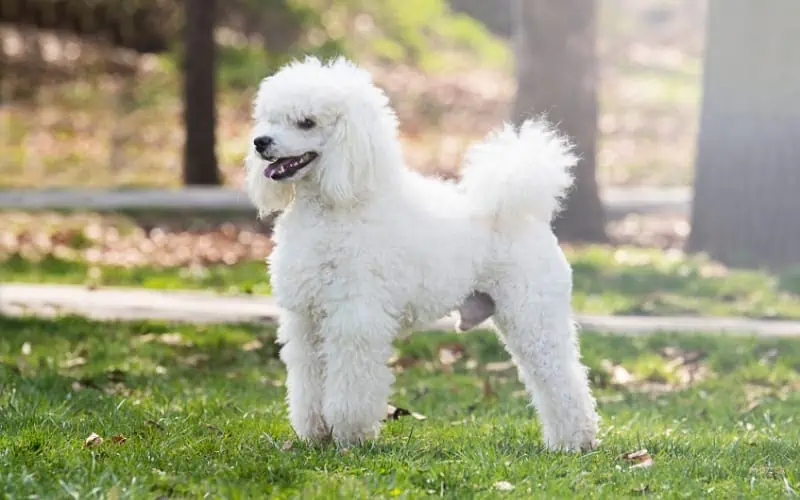
Somewhat counterintuitively, the second-most common Poodle color is white! Although these Poodles exhibit recessive gene expression, something that often makes some Poodle hair colors rare, white Poodles have been bred in such high quantities and for such a long time that they’re far from rare.
That said, white Poodles aren’t the same as albino Poodles (which are rare due to genetic mutations). While albino Poodles have pale pink skin due to a lack of melanin production, white Poodles have black skin, just like their black-haired counterparts.
These Poodles also have dark eyes and noses. But their hair is cotton-white instead of the more common ink-black hue.
Why Is It So Rare?
Comparatively speaking, white Poodles aren’t very rare. In addition to black Poodles, white Poodles are some of the most common of the bunch!
That said, white-coated Poodles are slightly rarer than black-coated ones. Additionally, their snow-white curly coats are the result of recessive gene expression.
So, if you breed a white Poodle with a black Poodle, the chances of creating all-white offspring are very low. That’s because black hair is a dominant gene in Poodles, while white hair is recessive. White “spotting” in Poodles is far more common than solid-white coats.
9. Brown
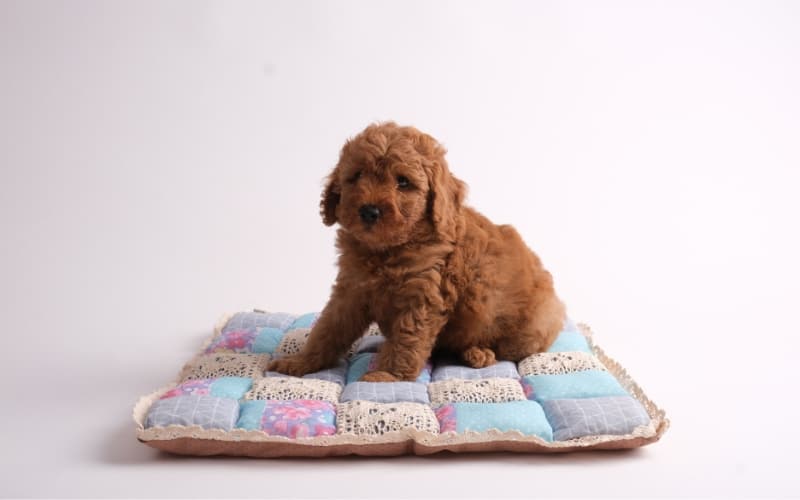
Brown Poodles, also called Chocolate Poodles, have dark, rich brown hair. Although this hair color isn’t the rarest of all Poodle coat colors, it’s slightly rarer than solid-white or solid-white hairs.
Like black Poodles, brown Poodles exhibit dominant gene expression. So, if you were to breed a black-haired Poodle with a brown-haired one, you’d likely end up with a pretty even mix of brown-haired and black-haired offspring.
However, some may consider brown-coated Poodles rarer than black-coated ones, as many brown Poodles carry a progressive graying gene (called G-Locus) that causes their hair to become a gray-silver or beige color as they age.
So, just because your Poodle puppy has gorgeous chestnut-brown locks while it’s young doesn’t mean it’ll stay brown forever!
Why Is It So Rare?
Although brown Poodles aren’t quite as rare as Poodles with other coat colors, they’re slightly rarer than solid black and white Poodles due to a wide range of factors, including genetic variation.
Many brown Poodles turn reddish-beige or gray as they age because they possess a graying gene. Other Poodles exhibit several different colors due to complex genetic backgrounds.
Tracking Poodle color can be an extremely challenging process, even for experienced breeders.
Poodles can possess multiple recessive genes, and when these genes combine, they can create an almost limitless range of coat color combinations. As such, solid-colored Poodles might be a breed standard, but they’ve become far less common due to the unexpected expression of previously unknown recessive genes.
And that brings us to sable Poodles.
8. Sable
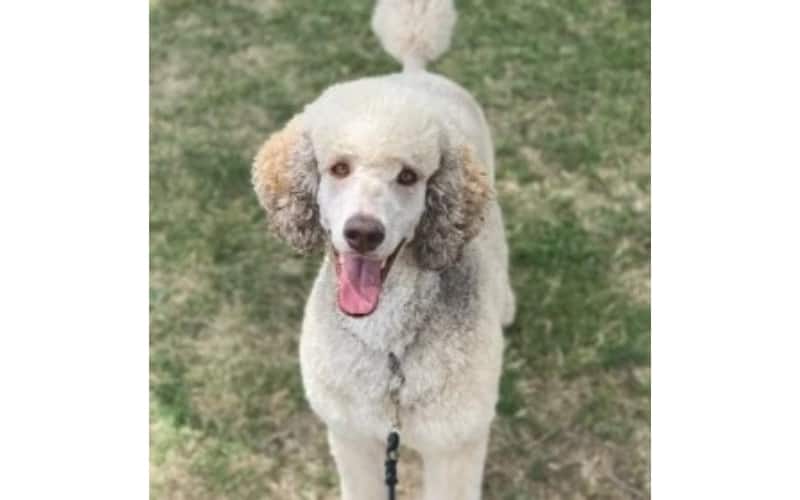
Even though sable isn’t an officially recognized Poodle standard color (at least, not by American Kennel Club standards), sable Poodles have become slightly more common over the last few decades thanks to private breeding practices.
Sable Poodles are typically born with dark hair, either black or brown. But as they get older, their coats become lighter, but the tips of their hair retain the original coloration.
The final result is a multi-colored coat that seems to follow a unique gradient. Sable Poodles can appear cream-colored, but the black tips of their longer curls (usually around the ears and tail) reveal the true coat color.
Why Is It So Rare?
Sable Poodles were once quite rare, as breeders used to primarily focus on creating solid-colored Poodles. But as more Poodle owners have engaged in small-yield breeding practices, solid-colored Poodles have given way to a dizzying array of color combinations, making sable Poodles more common.
However, sable Poodles differ slightly from phantom and tricolor Poodles. Instead of having random patches of white or colored hair along their bodies, sable Poodles have distinct coats that grow lighter with age. These coats also have hairs that feature black or dark brown tips, regardless of the dog’s primary hair color.
The genetic combination required to create this look is unique and comparatively unusual, making sable Poodle pups harder to find than their solid-colored counterparts. Well, for the most part anyways.
Some solid-colored Poodles are rarer than sable Poodles, including blue Poodles.
7. Blue
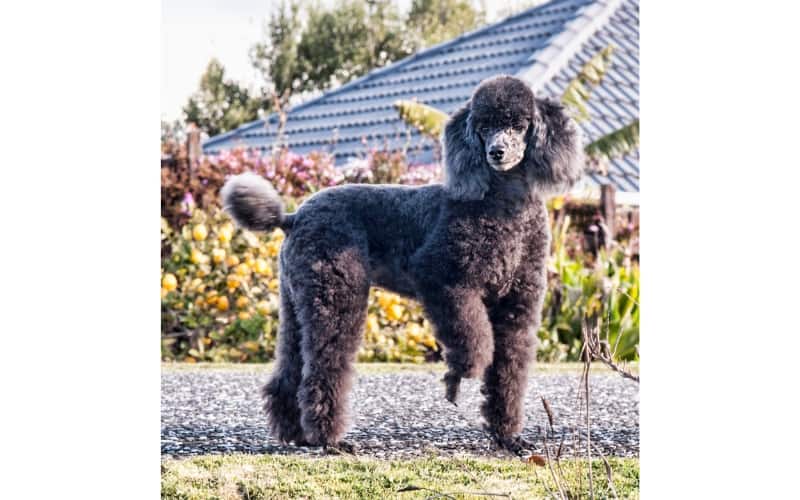
Blue Poodles don’t get their name from a melancholic disposition. Instead, this type of Poodle is so-called because of its gray-black coat color!
Essentially, blue Poodles are black Poodles that have lighter-than-average coats. But these pups aren’t exactly born with this coat color.
Instead, most blue Poodles develop their unique (and comparatively rare) hair color as they develop. These coat color changes might result from the progressive graying gene or have mixed genes that allow for some expression of silver hair.
The only way to find out for sure is to have a blue Poodle’s genes tested.
Why Is It So Rare?
Black Poodles are the most common type of Poodle on the planet, but as we’ve mentioned throughout this ranking, Poodle genetics can quickly get complicated.
You can breed multiple generations of black Poodles and create solid-black offspring, only for a seemingly “random” blue Poodle to pop up in the fourth, fifth, or sixth generation. That’s because dozens of genes control Poodle hair color, and many are recessive.
Combining just the right genes to end up with a blue Poodle is somewhat unlikely, making this Poodle hair color comparatively rare.
6. Silver
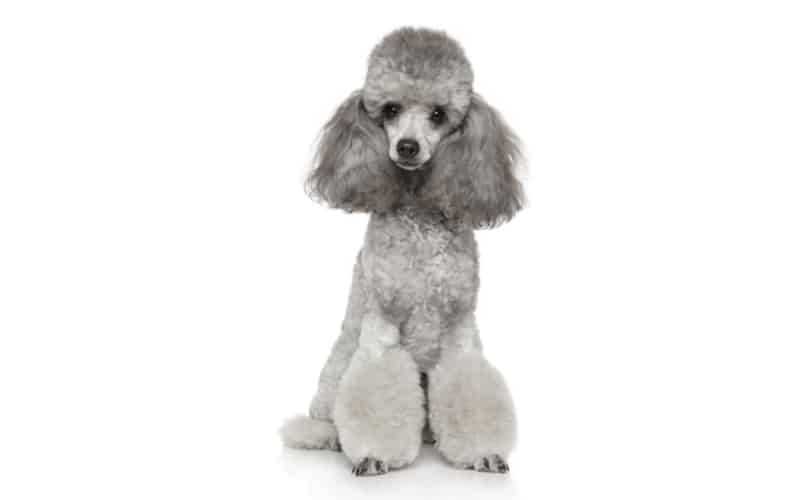
Silver hairs are responsible for giving mostly black Poodles their blue hue, but some Poodle pups have almost all silver hair instead. But this doesn’t mean that silver Poodles are completely silver.
In fact, nearly all silver Poodles are born with black skin and hair. This can make them impossible to recognize while they’re puppies, as they don’t typically begin showing their “adult” coats until they’re at least a year old.
Still, these Poodles are notable for their silver-gray coats, which can begin developing (also called clearing or lightening) while they’re still very young. These dogs have an extremely refined and elegant appearance that contrasts with gray-haired Poodles exhibiting the progressive graying gene.
Why Is It So Rare?
The silver hair color is recessive. As such, to create silver Poodle puppies, you’d need to breed silver-coated Poodles with a long history (pedigree) of silver-coated ancestors.
If any other recessive genes happen to be present in a Poodle parent’s pedigree (such as genes for red, cream, or apricot hair), the offspring could end up being anything from silver to Café Au Lait. And we’re not talking about the coffee drink! Well, not exactly.
5. Café Au Lait
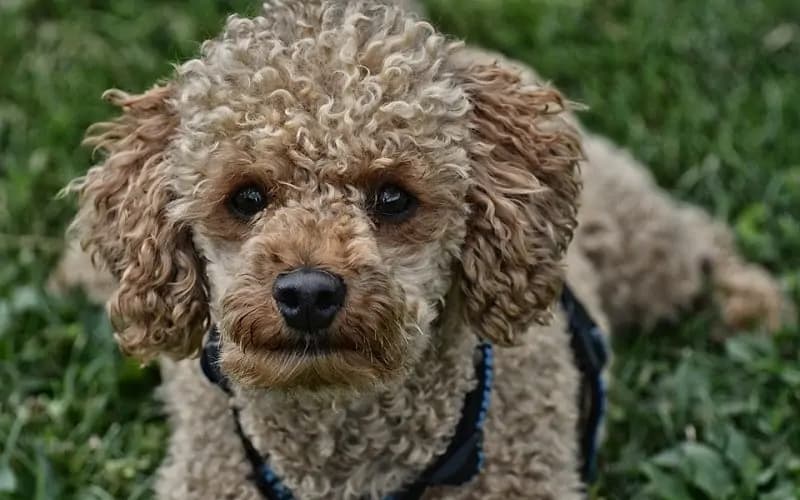
A refreshing cup of café au lait (coffee with milk) might be the ideal way to start your morning, but what does it mean when it refers to Poodle coat coloration?
Well, imagine that you have a cup of coffee and you add a sizeable pour of fresh milk. That coffee would likely take on a creamy brown color, right? That’s what Café Au Lait Poodles look like.
They exhibit a mixture of brown and cream colors that can be somewhat homogenous (spread evenly across the body) or spotty. As you might imagine, this unique mixture of colors isn’t exactly easy to reproduce, which is why Café Au Lait Poodles are some of the rarest.
Why Is It So Rare?
From a technical standpoint, Café Au Lait Poodles are the result of mixing brown (chocolate) Poodles with apricot and cream Poodles. But while brown is a dominant hair color, cream and apricot are recessive.
Consequently, the likelihood of producing a Café Au Lait Poodle is low compared to the likelihood of producing solid-brown or multi-color puppies. And speaking of multi-colored Poodle puppies, it’s time to address an even rarer Poodle color; the parti Poodle.
4. Parti
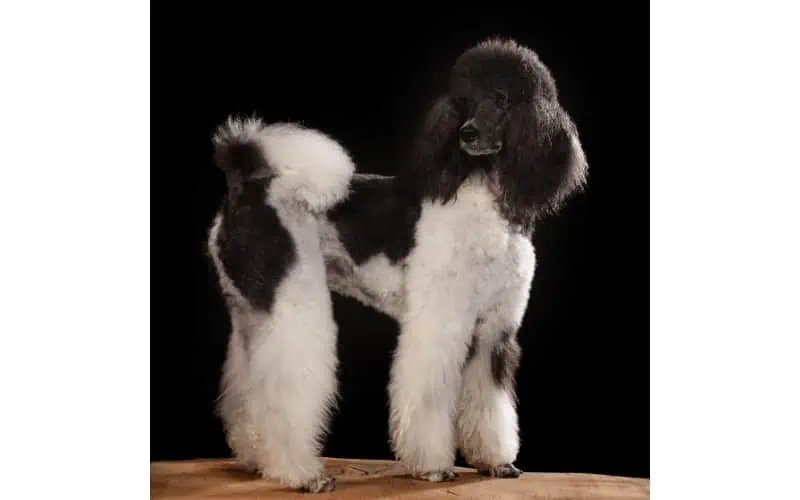
Despite what the name of this coat color might have you believe, parti Poodles aren’t staying up all night throwing ragers with the neighborhood dogs. Instead, this Poodle’s coat color name comes from the fact that it’s partially white and partially another color.
This unique combination of hues typically presents itself in a specific way. For example, parti Poodles almost always have white hair along their chests, legs, tails, and lower backs. But their heads, upper backs, and ears can be a different hair color.
Most parti Poodles and white and brown, but some can be white and apricot or white and black. Because white is a recessive hair color in Poodles, while brown and black are dominant, creating parti Poodles is often more a genetic lottery win than a surefire breeding practice.
Why Is It So Rare?
To produce a parti Poodle, you need just the right genes in just the right combination. Although dog breeding practices have come a long way over the last century, purposely creating parti Poodle offspring (even from parti Poodle parents) is challenging, as the genetic factors involved in creating this unique coat pattern are manifold.
3. Cream
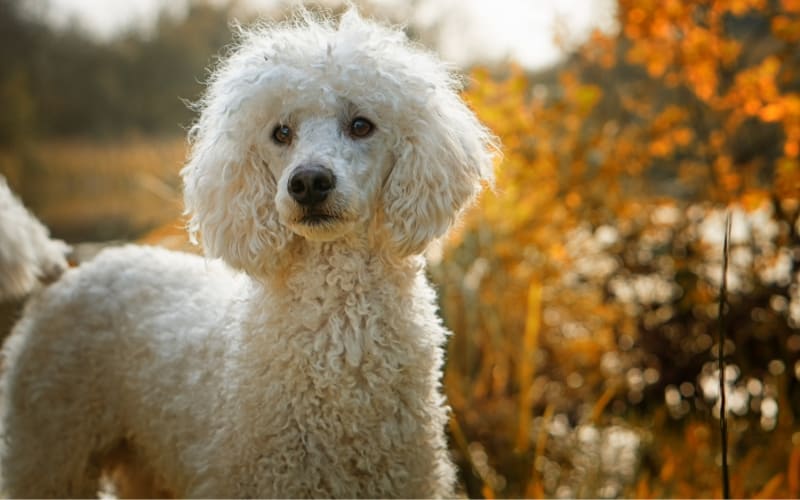
Have you ever wondered what a cross between a Golden Retriever and Poodle might look like? If so, set your eyes on the cream Poodle, a rare pup with a golden coat similar in color to that of Golden Retrievers and Goldendoodles.
Like many other rare Poodle colors, the cream coat results from recessive gene expression. It might be the product of breeding silver and red Poodles, though it’s hard to say, especially since cream-colored Poodles are so rare.
Why Is It So Rare?
Purebred Poodles are rarely cream-colored, though Poodle-Retriever hybrids (like the Goldendoodle) exhibit this hair color far more often.
For a purebred Poodle to have cream-colored hair, it needs a very specific genetic background that often includes having multiple generations of red and silver parents, each with a full lineup of recessive genes.
2. Red
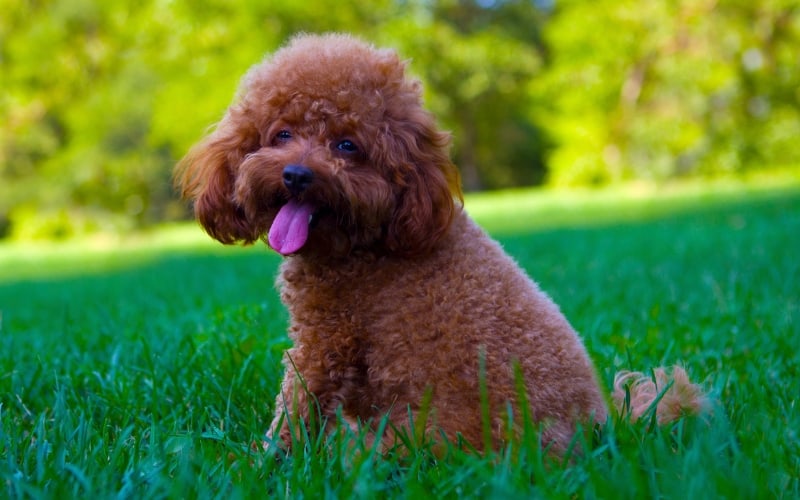
Like red hair in humans, red coloration in Poodles is very rare. This coat color is recessive, so Poodles that inherit dominant genes controlling hair color might carry and pass down the gene for red hair without ever having red-haired offspring!
Additionally, it can be tricky to tell brown or chocolate Poodles apart from red ones. That’s because these coat colors are very similar. Still, red Poodles have a noticeable ginger tinge to their brownish hair.
Red is one of the newest breed standard colors for Poodles, finally receiving official recognition in 1980. They’re also some of the rarest Poodles, in no small part thanks to genetics.
Why Is It So Rare?
While many Poodle genes have been studied and verified, the gene for red hair in Poodles is still under investigation.
While it’s clear how this coat color emerged (decades of selective breeding), the precise gene responsible for this hue is mysterious. At least one thing is for sure, however; without apricot Poodles, red Poodles wouldn’t exist.
1. Apricot
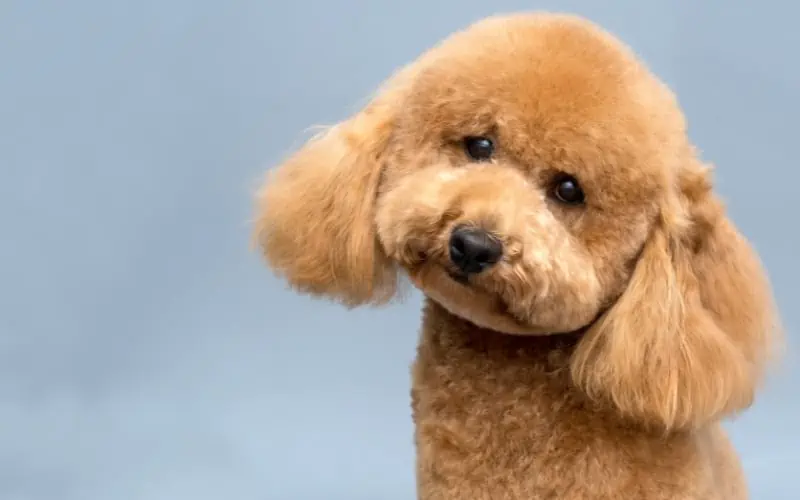
The rarest Poodle color is apricot. This coloration gets its name from the golden-red look of apricot fruits. Poodles with apricot coats typically look golden brown, but there are often slight tinges of red to their hair.
Because apricot hair is the rarest among Poodles, you’ll find that apricot-colored Poodles are often far more expensive than their brown (chocolate) or black counterparts. While solid-black Poodle puppies can sell for up to $3,000, apricot Poodle puppies often sell for $4,000 or more.
But what is it about these reddish-brown Poodles that makes them so unusual?
Why Is It So Rare?
The golden-red hue of an apricot Poodle’s curly coat results from highly unlikely genetic combinations. Essentially, these Poodles are only born when both parents carry the recessive gene for this distinct coat color.
But because most Poodles are black, brown, or white, the chances of breeding two Poodles and creating apricot-colored offspring is slim, especially when those parents don’t have cream, red, or apricot hair genes.
Still, it’s interesting to note that the apricot coat color in Poodles isn’t new. In fact, the emergence of this hair color dates back to the late 19th century, to a pup named Sowden Yellow Gal (some sources say Sowden Yellow Gall). So, unlike many hybrid dogs that exhibit rare hair colors and cost a pretty penny, the apricot Poodle’s history goes back quite a ways.
What’s the Most Common Poodle Color?
The most common Poodle color is black. That’s because darker hair colors (like black) are dominant, while lighter hair colors (like cream) are recessive.
If you breed a black Poodle with a white one, there’s an excellent chance that most of the puppies will have full black coats, with only a few exhibiting either sable or part coat patterns. The chances of an all-white Poodle being born from this mix are quite low.
You can see the same dominant-recessive traits passed down in humans, particularly hair and eye coloration.
Darker hues like brown or black are more dominant than lighter hues like blonde or blue, so the chances of two brown-haired people giving birth to a blonde-haired child are extremely low, even if both parents carry recessive genes for blonde hair.
While human and Poodle genetics aren’t identical, the way genes control physical traits is very similar in both!
What’s the Rarest Poodle Color in the World?
The rarest Poodle color in the world is apricot, a sort of creamy brown color with tints of red.
This coat color is rare, as it’s an expression of recessive genes. The chances of a red Poodle and a cream Poodle producing apricot-colored offspring is unlikely, as most of the puppies born from this coupling will be either red or cream, not a mixture of both.
Eager to learn more about the world’s rarest and most expensive plants and animals? Check out these related articles now!

